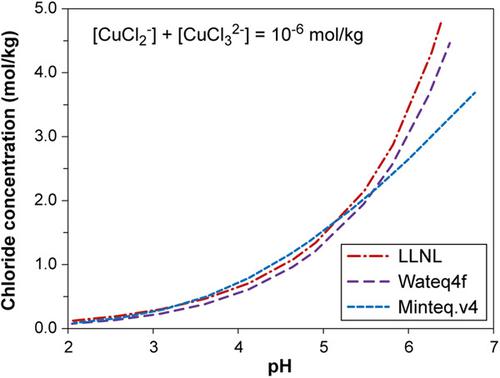当前位置:
X-MOL 学术
›
Mater. Corros.
›
论文详情
Our official English website, www.x-mol.net, welcomes your
feedback! (Note: you will need to create a separate account there.)
Speciation of copper in high chloride concentrations, in the context of corrosion of copper canisters
Materials and Corrosion ( IF 1.6 ) Pub Date : 2020-06-09 , DOI: 10.1002/maco.202011778 Christina Lilja 1 , Fraser King 2 , Ignasi Puigdomenech 1 , Barbara Pastina 3
Materials and Corrosion ( IF 1.6 ) Pub Date : 2020-06-09 , DOI: 10.1002/maco.202011778 Christina Lilja 1 , Fraser King 2 , Ignasi Puigdomenech 1 , Barbara Pastina 3
Affiliation

|
Canisters with a cast iron insert for mechanical strength and a 50‐mm thick copper shell as corrosion protection are planned to be used for disposal of spent nuclear fuel in Sweden and Finland. Chloride can be considered “beneficial”, as it promotes active dissolution of copper rather than passivation (which might result in pitting), but a high concentration of chloride in solution would increase the driving force for corrosion through the formation of soluble copper chloro complexes. Thermodynamic calculations are performed in this study with the PHREEQC software and three of its accompanying databases, and a comparison with experimental data is performed to select the database to be used when evaluating repository performance. The activity coefficient models are given special attention. For the assessment of chloride‐assisted corrosion of a KBS‐3 canister, chloride concentrations pessimistically up to 5 mol/kg are used (in Finland and Sweden, the groundwater and bentonite porewater chloride concentrations are not expected to exceed 1 mol/kg). The resulting copper solubilities are then considered in different mass transport cases.
中文翻译:

在铜罐腐蚀的情况下,高氯化物浓度下的铜形态
计划在瑞典和芬兰使用带有铸铁插件以提高机械强度的罐以及厚度为50 mm的铜壳作为腐蚀防护剂,用于处理乏核燃料。氯化物被认为是“有益的”,因为它促进铜的主动溶解而不是钝化(这可能会导致点蚀),但是溶液中高浓度的氯化物会通过形成可溶性铜氯配合物而增加腐蚀的驱动力。在这项研究中,使用PHREEQC软件及其三个随附数据库进行了热力学计算,并与实验数据进行了比较,以选择用于评估存储库性能的数据库。活度系数模型应特别注意。为了评估KBS-3罐的氯化物辅助腐蚀,悲观地使用了高达5 mol / kg的氯化物浓度(在芬兰和瑞典,地下水和膨润土孔隙水中的氯化物浓度预计不会超过1 mol / kg)。然后在不同的大宗运输案例中考虑所得的铜溶解度。
更新日期:2020-06-09
中文翻译:

在铜罐腐蚀的情况下,高氯化物浓度下的铜形态
计划在瑞典和芬兰使用带有铸铁插件以提高机械强度的罐以及厚度为50 mm的铜壳作为腐蚀防护剂,用于处理乏核燃料。氯化物被认为是“有益的”,因为它促进铜的主动溶解而不是钝化(这可能会导致点蚀),但是溶液中高浓度的氯化物会通过形成可溶性铜氯配合物而增加腐蚀的驱动力。在这项研究中,使用PHREEQC软件及其三个随附数据库进行了热力学计算,并与实验数据进行了比较,以选择用于评估存储库性能的数据库。活度系数模型应特别注意。为了评估KBS-3罐的氯化物辅助腐蚀,悲观地使用了高达5 mol / kg的氯化物浓度(在芬兰和瑞典,地下水和膨润土孔隙水中的氯化物浓度预计不会超过1 mol / kg)。然后在不同的大宗运输案例中考虑所得的铜溶解度。











































 京公网安备 11010802027423号
京公网安备 11010802027423号